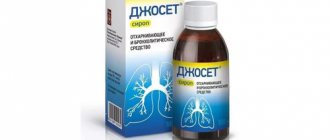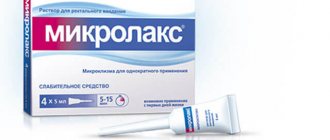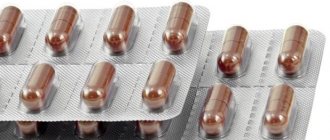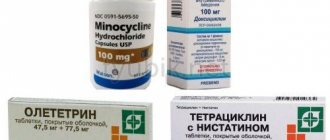Compound
1 tablet contains 100 mg of pentoxifylline.
Additionally (together with the shell): anhydrous colloidal silicon, sodium carmellose, lactose monohydrate, methylparaben, corn starch, talc, acacia gum, magnesium stearate, crystalline and powdered sucrose, titanium dioxide.
1 tablet of CP contains 400 mg or 600 mg of pentoxifylline
.
Additionally (together with the shell): hypromellose, talc, macrogol 6000, magnesium stearate, povidone 40, sepifilm 752 white, dimethicone emulsion.
1 ml of injection solution includes 20 mg of pentoxifylline
.
Additionally: water for injection, sodium chloride.
Pharmacodynamics and pharmacokinetics
Agapurin is an antispasmodic
medicinal agent and belongs to the group of purines.
The action of pentoxifylline
is aimed at improving the rheological qualities of blood and enhancing microcirculation.
The effectiveness of pentoxifylline
is manifested due to its ability to suppress
phosphodiesterase
and increase the concentration of ATP in
erythrocytes
and
cAMP
in
platelets
with parallel filling
of energy potential
.
This mechanism of action leads to noticeable vasodilation, a decrease in the total resistance of peripheral vessels, an increase in minute and stroke volume of blood and occurs without significant changes in heart rate.
Pentoxifylline has a dilating effect on the pulmonary vessels
and
coronary arteries
, thereby increasing the delivery of oxygen to the bloodstream and to the heart muscle (
antianginal
effect) and increasing the tone of the muscles of the respiratory system (diaphragm and intercostal muscles).
When pentoxifylline
intravenously, an increase
in collateral circulation
and an increase
in the volume of blood
passing through a sectional unit are observed.
In the brain there is an increase in the concentration of ATP and an increase in the bioelectrical activity of the central nervous system. decreases and the elasticity of erythrocyte membranes increases
(due to the effect of the drug on pathologically deformed erythrocytes).
microcirculation
increases . With intermittent claudication, the maximum walking distance increases, and the severity of pain at rest and the frequency of nighttime cramps of the lower extremities (mainly the calf muscles) decreases.
Pentoxifylline is characterized by rapid hepatic metabolism with the release of several active metabolic products. The most significant metabolites are considered to be 1-3-carboxypropyl-3,7-dimethylxanthine
, the plasma concentration of which is 8 times higher than the serum content
of pentoxifylline
and 1-5-hydroxyhexyl-3,7-dimethylxanthine, the plasma level of which is 5 times higher than
pentoxifylline
.
The bioavailability of this drug is variable and ranges from 6-32%. Concurrent food intake increases the Cmax of pentoxifylline by 28% and its AUC by 13%, while the Cmax of 1-5-hydroxyhexyl-3,7-dimethylxanthine
increases by 20%.
When taken orally with simple tablets, the average TCmax of pentoxifylline
is 60 minutes, when taking retard tablets - 120-240 minutes.
After a half-hour infusion with pentoxifylline
at a dose of 200 mg, its Vd is at the level of 168 liters, and the clearance is 4500-5100 ml/min.
Observed T1/2 after drip infusion of 100 mg pentoxifylline
is 1.1 hours, after internal administration of tablets - 0.4-0.8 hours. T1/2 of two significant metabolic products ranges from 1 to 1.6 hours.
Excretion is 94% by the kidneys and 4% by the intestines, in the form of metabolites. During the first 4 hours, about 90% of pentoxifylline
.
For severe kidney pathologies
there is a slow elimination of metabolites.
For liver pathologies
There is an increase in bioavailability and an increase in T1/2.
pharmachologic effect
The drug has an antispasmodic effect, improving arterial or venous microcirculation without increasing the heart rate.
Additionally, the product eliminates intense pain in the lower extremities due to atherosclerosis.
Pharmacokinetics
When administered orally, the drug is absorbed from the digestive tract into the systemic circulation.
The breakdown products of the active substance are excreted primarily by the kidneys along with urine, and also in a small volume with feces.
In chronic renal failure, a slow process of excretion of metabolites is observed.
https://youtube.com/watch?v=H8hjgG-aRTk
Indications for use
The use of Agapurin is indicated for the treatment of:
- disorders of peripheral blood supply occurring against the background of inflammatory
, diabetic, atherosclerotic processes (including
intermittent claudication
associated with
obliterating endarteritis
,
diabetic angiopathy
, atherosclerosis); - angioneuropathies
(including
acrocyanosis
,
paresthesia
,
Raynaud's disease
); - trophic tissue disorders
caused by pathologies of
venous
or arterial microcirculation (including
frostbite
, gangrene and
varicose ulcers
); - pathologies of cerebral circulation
of ischemic etiology of acute and chronic course (including
cerebral atherosclerosis
); - ocular circulatory
disorders (including insufficiency of blood supply to the choroid and retina of the eye); - conditions observed after a stroke
, both
ischemic
and hemorrhagic; - vascular dysfunction
of
the middle ear
with observed hearing loss.
pharmachologic effect
Agapurine belongs to the group of purines and has a moderate antispasmodic (i.e., relaxes smooth muscles) effect. Due to this, it improves blood flow even in the smallest vessels and helps improve the rheological characteristics of the blood. Pentoxifylline-induced vasodilation leads to a decrease in total peripheral vascular resistance and an increase in stroke and cardiac output. There is no increase in heart rate.
The mechanism for preventing thrombus formation is associated with irreversible inhibition of phosphodiesterase, an increase in the concentration of cAMP in platelets and the accumulation of ATP in erythrocytes. No less important is the mechanism of Agapurin’s effect on the coronary arteries. Pentoxifylline exhibits a moderate antianginal effect due to the expansion of not only the blood vessels of the heart, but also the lungs. The drug has the ability to increase the tone of the diaphragm and intercostal muscles (respiratory muscles).
For occlusive diseases of the lower extremities (obliterating endarteritis or atherosclerosis), the drug, due to its antispasmodic and antiplatelet action, effectively eliminates night cramps, increases walking distance, and relieves pain in the calf muscles at rest.
Contraindications
The use of Agapurin is absolutely contraindicated for:
- severe atherosclerosis
(cerebral or coronary); - pregnancy;
- myocardial infarction
(in its acute period); - porphyria
; - breastfeeding;
- significant heart rhythm disturbances
; - hemorrhagic stroke
(in its acute period); - personal hypersensitivity
to
pentoxifylline
and/or other components of the drug; - uncontrolled arterial hypotension
; - hemorrhages in the retina
; - massive bleeding;
- under the age of 18 years.
Relative contraindications include:
- labile blood pressure;
- CHF
; - peptic ulcer;
- predisposition to arterial hypotension
; - tendency to hemorrhages;
- liver/kidney pathologies
; - postoperative conditions.
Agapurin - instructions, composition, dosage, side effects of use
Agapurin
Agapurin _
international and chemical name: pentoxifylline; 3,7-dimethyl-1-(5-oxohexyl)-xanthine;
Basic physical and chemical characteristics : white dragees with a smooth, wallpaper-convex surface;
Compound. 1 tablet includes pentoxifylline 100 mg;
other ingredients: lactose monohydrate, corn starch, talc, magnesium stearate, anhydrous colloidal silicon dioxide, sodium carmellose, molasses-like sucrose, powdered sucrose, acacia, titanium dioxide, methylparaben.
Release form of the medicine. Dragee.
Pharmacotherapeutic group. Peripheral vasodilators. ATS code C04AD03.
Action of the medicine . Pharmacodynamics. Pentoxifylline relaxes the smooth muscles of arterioles directly and due to inhibition of the phosphodiesterase enzyme, after which cyclic AMP accumulates. Pentoxifylline reduces blood viscosity, mainly in the capillaries. As a result, blood flow and oxygen supply to tissues improve. It inhibits platelet aggregation and adhesion. Pentoxifylline increases the flexibility and elasticity of red blood cells, increasing the concentration of ATP in the external environment. Pentoxifylline probably has an anti-inflammatory and cytoprotective effect, which is based on a decrease in the synthesis of macrophage cytokines and a decrease in neutrophil activation. These properties can be used in the treatment of bronchial asthma, sepsis and endotoxic shock.
Pharmacokinetics. When taken orally, pentoxifylline is quickly and almost completely (more than 95%) absorbed from the gastrointestinal tract. Pentoxifylline binds to erythrocyte membrane proteins, its biotransformation occurs in the liver and in erythrocytes. Approximately 94% and 4% of pentoxifylline are excreted as metabolites in urine and feces, respectively. Approximately 2% of the applied dose is excreted as unchanged pentoxifylline. Up to 90% of the total dose is eliminated within 4 hours after use.
Indications for use of Agapurin.
Estracite - instructions, composition, dosage, side effects of use
— Chronic peripheral arterial and arteriovenous circulatory disorders due to atherosclerosis (atherosclerosis with intermittent claudication), diabetes mellitus (diabetic angiopathy), inflammation (obliterating endarteries), dystrophic disorders (postthrombotic syndrome, hip ulcer, gangrene, frostbite) and angioneuropathy (paresthesia, acrocyanosis, Raynaud's disease);
- disorders of cerebrovascular circulation (a condition caused by atherosclerosis, for example, decreased ability to concentrate, dizziness, memory impairment, as well as a condition after a stroke with persistent symptoms of cerebrovascular ischemia);
- acute and chronic retinal and choroidal vascular insufficiency;
- acute functional disorders of the inner ear.
Method of use and dose. The starting dose for adults is 200 mg of pentoxifylline (2 tablets) three times a day during the first week of treatment. In case of hypotension, negative reactions from the gastrointestinal tract or the central nervous system, the initial dose can be reduced to 100 mg of pentoxifylline (1 tablet) three times a day. Patients who have chronic diseases usually take 100 mg of pentoxifylline (1 tablet) three times a day.
For subjects with renal impairment, reduced doses are recommended (50 - 70% of the usual dose), creatinine level 400 mmol/l.
Do not exceed the maximum daily dose of 1200 mg.
The dragees should be taken whole with a small amount of liquid during or after meals, preferably at the same time.
Side effect. This drug is generally well tolerated, but the following side effects may occur:
gastrointestinal tract: nausea, vomiting and feeling of fullness in the stomach;
Aminocaproic acid - instructions, composition, dosage, side effects of use
central nervous system: headache, nervousness, agitation, sleep disturbance, increased sweating;
skin reactions: hypersensitivity (rash, urticaria, itching) is less common, it usually subsides after stopping or ending treatment;
cardiovascular system: tachycardia, arrhythmia, hypotension, the appearance of symptoms of angina pectoris, bleeding in various organs (especially in subjects prone to bleeding);
metabolism: hypoglycemia.
Contraindications . - Known hypersensitivity to pentoxifylline, other methylxanthines, or to any other components of the drug;
- bleeding (due to an increased risk of severe hemorrhage);
- retinal bleeding (due to an increased risk of severe hemorrhage);
- pregnancy and lactation;
— there is not enough experience in treating children and adolescents under 18 years of age, so it is not recommended to prescribe Pentoxifyel to them.
Exceeding the permissible dose of the drug (overdose). Symptoms: Initial symptoms of acute pentoxifylline overdose may include nausea, dizziness, tachycardia, or decreased blood pressure. Possible symptoms include fever, agitation, hot flashes, loss of consciousness, areflexia, tonic-clonic seizures, and vomiting coffee grounds as a sign of gastrointestinal bleeding.
Treatment: in case of overdose, further systemic absorption of pentoxifylline should be stopped by primary removal (for example, gastric lavage) or by delaying its absorption (for example, activated charcoal).
In case of acute overdose and in order to prevent complications, general and specialized medical control is necessary.
Features of use. Particular caution should be taken when prescribing the drug to patients with the following conditions:
- cardiac arrhythmias (risk of arrhythmia exacerbation);
- acute myocardial infarction (increased existing risk of cardiac arrhythmias and hypotension);
- hypotension (risk of further decrease in blood pressure;
Cotarnine chloride - instructions, composition, dosage, side effects of use
- renal dysfunction (creatinine clearance <30 ml/minute), patients at risk of overdose and adverse reactions;
- serious hepatic dysfunction, patients at risk of overdose and adverse reactions;
- bleeding diathesis, for example, patients treated with anticoagulants or patients with bleeding disorders.
The use of the drug does not affect the performance of work, which requires an increased speed of mental and physical reactions (for example, driving vehicles, machinery, working at height, etc.).
Interaction with other drugs. Pentoxifylline enhances the effect of antihypertensive and other vasodilators, which can cause severe hypotension. When used simultaneously with adrenergic and ganglion blockers, a significant decrease in blood pressure can be observed. The simultaneous use of adrenergic substances or xanthines leads to stimulation of the central nervous system. Higher doses of pentoxifylline potentiate the effect of insulin and oral hypoglycemic agents. Due to the risk of hypoglycemia, it is recommended to measure blood glucose more often and, over time, adjust antidiabetic therapy. Pentoxifylline increases the incidence of hemorrhage complications in patients who are simultaneously treated with anticoagulants, antiplatelet and thrombolytic agents. In patients being concomitantly treated with anticoagulants, prothrombin time should be measured more frequently. Cimetidine increases the plasma concentration of pentoxifylline, thereby increasing the risk of adverse reactions to it.
Features of conditions, shelf life and sales. . Keep in a dry place, out of reach of children, at temperatures up to 25 °C. Shelf life – 5 years.
Sources of information: rsml.med.by, mednet.by, drugs.com, webmd.com.
Side effects
Sense organs:
- scotoma
; - visual disturbances.
Nervous system:
- the occurrence of seizures;
- headache;
- feeling of anxiety;
- dizziness;
- sleep disorders
.
Skin:
- facial hyperemia
; - brittle nails;
- hot flashes
(usually in relation to the upper chest and face); - swelling.
The cardiovascular system:
- progression of angina pectoris;
- tachycardia;
- cardialgia;
- decreased blood pressure;
- arrhythmias.
Digestive system:
- intestinal atony
; - feeling of heaviness in the stomach;
- exacerbation of cholecystitis;
- nausea, vomiting;
- gastrointestinal bleeding
; - decreased appetite;
- cholestatic hepatitis
.
Blood-forming organs:
- pancytopenia;
- hypofibrinogenemia;
- thrombocytopenia;
- development of bleeding from skin vessels;
- leukopenia.
Allergic manifestations:
- hives
; - itching
sensation ; - Quincke's edema;
- skin hyperemia;
- anaphylactic shock.
Laboratory research indicators:
- increased levels of liver transaminases
.
AGAPURIN
A drug that improves microcirculation. Angioprotector
Release form, composition and packaging
Film-coated tablets
white, round, shiny, biconvex.
| 1 tab. | |
| pentoxifylline | 100 mg |
Excipients:
lactose monohydrate, corn starch, talc, magnesium stearate, colloidal anhydrous silicon.
Shell composition:
sodium carmellose, crystalline sucrose, powdered sucrose, talc, methylparaben, titanium dioxide, anhydrous colloidal silicon, acacia gum.
60 pcs. - dark glass bottles (1) - cardboard packs.
pharmachologic effect
Antispasmodic agent from the group of purines. Improves microcirculation and rheological properties of blood.
The mechanism of action is associated with inhibition of phosphodiesterase and accumulation of cAMP in platelets and ATP in erythrocytes with simultaneous saturation of energy potential, which in turn leads to vasodilation, a decrease in total peripheral vascular resistance, an increase in stroke and minute blood volume without a significant change in heart rate.
By dilating the coronary arteries, it increases the delivery of oxygen to the myocardium (antianginal effect), and by dilating the blood vessels of the lungs, it improves blood oxygenation. Increases the tone of the respiratory muscles (intercostal muscles and diaphragm).
Reduces blood viscosity, increases the elasticity of the erythrocyte membrane (due to the effect on the pathologically altered deformability of erythrocytes). Improves microcirculation in areas of poor circulation.
With occlusive lesions of the peripheral arteries (“intermittent” claudication), it leads to an increase in walking distance, elimination of night cramps of the calf muscles and pain at rest.
Dosage
The tablets are taken orally, without chewing, regularly at the same time, preferably after meals.
The drug is taken starting from 200 mg (2 tablets) 3 times a day during the first week; in case of severe arterial hypotension and symptoms of irritation from the gastrointestinal tract or central nervous system, the initial dose is reduced to 100 mg (1 tablet) 3 times a day.
During a course of treatment, 100 mg (1 tablet) is prescribed 3 times a day. The maximum daily dose is 1200 mg/day.
In case of insufficient renal function with creatinine levels above 400 mmol/l, the dose is reduced by 30-50%.
From the side of the central nervous system:
headache, dizziness; anxiety, sleep disturbances, seizures.
For the skin and subcutaneous fat:
hyperemia of the facial skin, “flushes” of blood to the skin of the face and upper chest, swelling, increased brittleness of nails.
From the digestive system:
dry mouth, decreased appetite, intestinal atony, exacerbation of cholecystitis, cholestatic hepatitis.
From the senses:
blurred vision, scotoma.
From the cardiovascular system:
tachycardia, arrhythmia, cardialgia, progression of angina, decreased blood pressure.
From the hematopoietic organs and hemostasis system:
thrombocytopenia, leukopenia, pancytopenia, hypofibrinogenemia; bleeding from blood vessels of the skin, mucous membranes, stomach, intestines.
Allergic reactions:
itching, skin hyperemia, urticaria, angioedema, anaphylactic shock.
Laboratory indicators:
increased activity of liver transaminases: ALT, AST, LDH and alkaline phosphatase.
Overdose
Symptoms:
weakness, dizziness, tachycardia, drowsiness, marked decrease in blood pressure, redness of the skin, loss of consciousness, increased body temperature (chills), areflexia, tonic-clonic convulsions, signs of gastrointestinal bleeding (vomiting “coffee grounds”).
Treatment:
symptomatic, aimed at maintaining respiratory function and blood pressure.
Drug interactions
Pentoxifylline may enhance the effect of drugs that affect the blood coagulation system (indirect and direct anticoagulants, thrombolytics), antibiotics (including cephalosporins - cefamandole, cefoperazone, cefotetan), valproic acid.
Increases the effectiveness of antihypertensive drugs, insulin and oral hypoglycemic agents.
Cimetidine increases the concentration of pentoxifylline in the blood plasma (risk of side effects).
Concomitant use with other xanthines may lead to excessive nervous stimulation.
special instructions
For patients with labile blood pressure and a tendency to arterial hypotension and patients with severe renal impairment, the dose is increased gradually and selected individually.
Patients with severe renal impairment when taking Agapurin require especially careful medical supervision. If, during the period of use of the drug, patients experience hemorrhages in the retina of the eye, the drug is immediately discontinued.
Treatment should be carried out under blood pressure monitoring.
In patients with diabetes mellitus taking hypoglycemic agents, administration in large doses may cause hypoglycemia (dose adjustment required). When prescribed simultaneously with anticoagulants, it is necessary to carefully monitor the blood coagulation system.
In patients who have recently undergone surgery, systematic monitoring of hemoglobin concentration and hematocrit is necessary.
In older adults, dose reduction may be necessary (increased bioavailability and decreased rate of elimination).
Smoking may reduce the therapeutic effectiveness of the drug.
Pregnancy and lactation
Contraindicated during pregnancy and lactation.
Use in childhood
Contraindication: age under 18 years (efficacy and safety have not been established).
For impaired renal function
In case of insufficient renal function with creatinine levels above 400 mmol/l, the dose is reduced by 30-50%.
For liver dysfunction
Carefully:
liver failure.
Use in old age
In older adults, dose reduction may be necessary (increased bioavailability and decreased rate of elimination).
Conditions for dispensing from pharmacies
The drug is available with a prescription.
Storage conditions and periods
Store at a temperature of 15-25°C in a dry place, protected from light and out of reach of children.
Shelf life - 5 years.
The description of the drug AGAPURIN is based on officially approved instructions for use and approved by the manufacturer.
Found an error? Select it and press Ctrl+Enter.
Source: https://health.mail.ru/drug/agapurin/
Agapurin, instructions for use
Instructions for use of Agapurin include regular oral (at the same time of day) administration of both simple tablets and retard tablets. It is preferable to take the tablets immediately after meals in their entirety.
When prescribing treatment using conventional tablets, the first week of therapy is carried out at a dose of 200 mg (2 tablets) taken three times a day. In case of manifestation of negative symptoms from the central nervous system, gastrointestinal tract or a sharp decrease in blood pressure
the dosage should be halved while maintaining the frequency of taking tablets.
During course therapy, as a rule, a three-time dose of 100 mg (1 tablet) of Agapurin is prescribed per 24 hours, with a maximum permissible daily dose of 1200 mg.
In case of observed renal failure
with
creatinine
exceeding 400 mmol/l, a dosage reduction of 30-50% is practiced.
When using prolonged forms of the drug, Agapurin retard tablets, the therapeutic course and dosage are established individually in accordance with the clinical picture of the diagnosed disease and the therapeutic effect produced.
Agapurin 400 SR tablets should be taken 2-3 times a day, 600 SR - twice a day. The maximum permissible daily dosage is 1200 mg.
For kidney pathologies with CC less than 30 ml/min, you can take 2 tablets of 400 mg each in a maximum of 24 hours.
For severe liver pathologies
a reduction in the dosage of extended-release tablets is required, taking into account personal tolerance
to pentoxifylline
.
In case of prescribing Agapurin retard to patients with hypotension
or persons prone to
low blood pressure
(coronary heart disease, cerebral vascular
stenosis
, etc.), treatment should begin with minimal dosages
of pentoxifylline
, with their gradual increase to optimally effective values.
Agapurin injection solution can be administered intravenously, intravenously or intramuscularly, with the patient's body in a horizontal position.
Intravenous infusions are carried out in a daily dose of 100 mg (1 ampoule), dissolved in 250-500 ml of sodium chloride
(0.9%) or
dextrose
(5%) for 1.5-3 hours. If the response to the infusion is positive, the dosage may be doubled. A maximum of 300 mg can be administered intravenously per day.
Intra-arterial administration is initially carried out at a dose of 100 mg dissolved in 20-50 ml of sodium chloride
(0.9%).
Subsequently, 200-300 mg is prescribed in 30-50 ml of sodium chloride solution (0.9%). The rate of administration of 100 mg of Agapurin should be at least 10 minutes. In the case of observed severe cerebral
vascular atherosclerosis, the solution should not be injected into the carotid artery.
For kidney pathologies
with CC less than 10 ml/min, the dosage of injection Agapurin is reduced by 30-50%.
Intramuscular administration of the solution is carried out 1-2 times every 24 hours at a dose of 100 mg (1 ampoule).
Contraindications to the use of Agapurin in treatment
The medicine Agapurin, although safe, cannot be used for treatment in all cases. The decision on its use should be made by the attending physician, taking into account the patient's condition. Absolute contraindications are:
- Presence of retinal hemorrhage;
- Porphyria;
- Arrhythmia with severe, complicated course;
- Previous myocardial infarction;
- Stroke characterized as acute hemorrhagic;
- Atherosclerosis of cerebral and coronary vessels;
- Pregnancy or breastfeeding;
- The patient is under 18 years of age.
When prescribing Agapurin tablets, the instructions allow you to take the medicine with extreme caution in the following conditions:
- Arrhythmia;
- Presence of hypotension;
- Atherosclerosis of the heart vessels, the same for the vessels of the brain;
- For problems with cardiac activity;
- Liver failure, acute or chronic;
- Renal dysfunction, acute or chronic conditions;
- For stomach and duodenal ulcers.
If the patient for whom treatment is being selected has recently undergone surgery, Agapurin tablets should be prescribed to him only if seriously necessary. In this case, the attending physician should closely monitor the intake of the drug and check the person’s hematocrit and hemoglobin levels.
It is worth remembering that patients who have undergone surgery have an increased risk of bleeding; pentoxifylline in Agapurin can provoke their development.
Taking Agapurin 100, 400 during pregnancy
Agapurin Retard 400 and other types of instructions for use do not recommend use in the treatment of pregnant women. You should not use the drug during breastfeeding. The effect of the medicine can have a bad effect on the baby’s fragile body.
Regarding the use of the drug in the treatment of children, it can be said that there is no data on obvious harm to children's health. But there is no clear information about complete safety for the child’s body. Therefore, most doctors will not prescribe the medicine to patients under 15 years of age.
It is not recommended for patients under 18 years of age to take it.
Overdose
In case of an overdose of Agapurin, the following were observed: manifestations of weakness, decreased blood pressure
, feeling of dizziness, hyperthermia,
tachycardia
, fainting, increased drowsiness,
areflexia
,
loss of consciousness
, nervous
excitability
, tonic-clonic
convulsions
, phenomena
of gastrointestinal bleeding
(for example, vomiting “coffee grounds”).
Treatment of such conditions should be consistent with the observed symptoms, while simultaneously maintaining (if necessary) normal blood pressure and respiratory function.
Interaction
Parallel use of Agapurin with other xanthines
may cause increased
nervous excitement
.
Effects of pentoxifylline
may enhance the effect of
valproic acid
, drugs that affect blood clotting (
thrombolytics
, anticoagulants), as well as
antibiotics
(including cephalosporins).
Agapurin enhances the effectiveness of insulin
,
antihypertensive drugs
and oral hypoglycemic drugs.
Combination with Cimetidine
may increase plasma levels
of pentoxifylline
, which increases the possibility of side effects.
special instructions
Therapy with Agapurin should be carried out under constant blood pressure monitoring.
.
In patients with CHF,
it is necessary to achieve
circulatory compensation
.
When taking anticoagulants
It is necessary to closely monitor
blood clotting
.
The use of large doses of Agapurin for the treatment of patients with diabetes mellitus who are taking hypoglycemic drugs
, can lead to the formation of severe
hypoglycemia
, which requires adjustment of the dosage regimen.
In patients who have recently undergone surgery
hematocrit
concentrations should be systematically monitored .
When diagnosing a patient with underestimated
or
unstable blood pressure,
it is necessary to use the minimum effective dosage of Agapurin.
For the treatment of elderly patients, adjustment of the dosage regimen may be necessary due to a decrease in the rate of excretion
.
Nicotine-dependent patients may experience a decrease in the therapeutic effectiveness of Agapurin.
The compatibility of injection Agapurin with solutions for infusions must be checked separately.








